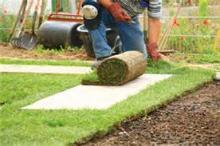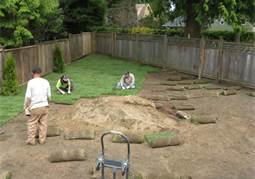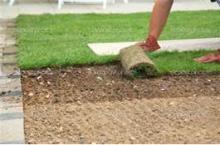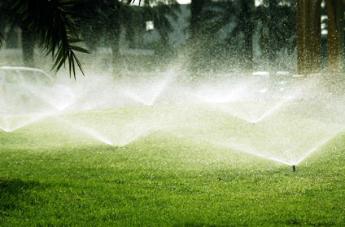Installation of Sod
The following are Turf grass Producers International (TPI) basic steps to a beautiful lawn. You may also download a PDF version here.
Step One: Measuring and Ordering

With a tape, measure the area of your planned lawn (or use our online calculator). Include these measurements on a sketch of the lawn area, with the length, width, and any unusual features. Schedule your on the day of delivery is crucial to a strong beginning for your lawn.
Area Calculators
Use the calculators below to calculate the amount of sod you need.
Step Two: Soil Preparation

For best result, rototill or spade the area to a depth of 10 to 15 cm. (4 to 6 in.). Eliminate drainage problems by having soil slope away from foundations, etc.
If possible, have a soil test of your prepared area by sending a sample of soil to your state Extension Service. See listing of State Extension Services at the end of this section. Then rake in fertilizer, lime, peat, compost, etc. As needed to a depth of 7 to 10 cm. (3 to 4 in.). Rake and smooth the soil removing rocks, roots, and large clods. Roll the area lightly with a lawn roller 1/3 full of water. This will firm the soil surface and reveal low areas that need more soil. Keep the grade 2 to 3 cm. (1 in.) below sidewalks or driveway.
Step Three: Turf Installation

Install your lawn immediately upon delivery. Begin watering lawn within 20 minutes of installation. Turf is a living plant that requires ground contact and moisture to survive!
In hot weather, protect unlaid turf by placing stacks in shade, covering with moist burlap sacking, and/or sprinkling.
Begin installing turf along the longest straight line, such as a driveway or sidewalk. Butt and push edges and ends against each other tightly, without stretching. Avoid gaps or overlaps. Stagger the joints in each row in a brick-like fashion, using a large sharp knife to trim corners, etc. Avoid leaving small strips at outer edges as they will not retain moisture.
To avoid causing indentations or air pockets avoid repeated walking or kneeling on the turf while it is being installed or just after watering. After installing the turf, roll the entire area to improve turf/soil contact and remove air pockets.
Step Four: Watering

Give your new lawn at least 2 to 3 cm. (1 in.) of water within 1/2 hour of installation. Water daily, or more often, keeping turf moist until it is firmly rooted (about 2 weeks). Then less frequent and deeper watering should begin. Generally we recommend watering every day the first week, every other day the second week and every third day the third week.
Weather conditions will dictate the amount and frequency of watering. Be certain that your new lawn has enough moisture to survive hot, dry, or windy periods.
Water areas near buildings more often where reflected heat dries the turf.
Caution
During first three weeks avoid heavy or concentrated use of your new lawn. This gives the roots an opportunity to firmly knit with soil and insures that the turf will remain smooth.
Maintenance
Your new sod lawn increases your property value significantly. With proper care. It will remain a great asset, providing beauty, a clean playing surface, and an improved environment.
Mow often. Generally removing no more than 1/3rd of the grass height at a mowing. Keep your mower blade sharp. You may need to mow twice a week at first. Keep mower cutting height set at not less than 2.5". A 3" cutting height in the summer months may be best as the taller height shades the soil reducing moisture loss.
Weed and chemical applications are generally not needed on a new sod installation. Another of the benefits of turf grass sod is that weeds and disease are not an issue.
